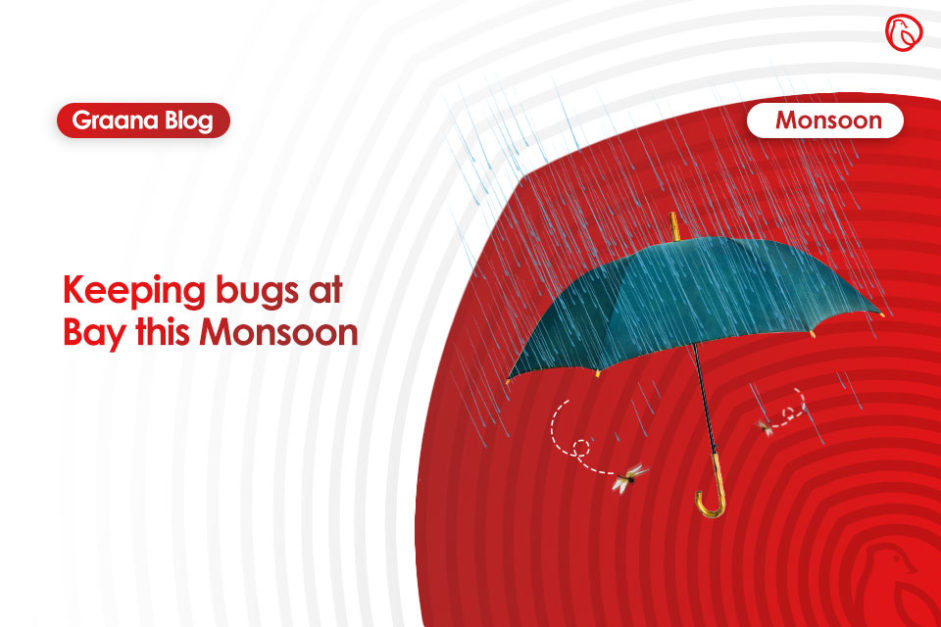As the rain clouds come floating in, the sun hides behind the clouds, turning the ground muddier. This makes many calm, happy and hopeful. Witnessing the Margallas in the Monsoon season is nothing short of a majestic sight. For many, it is the most awaited season of the year due to the pleasant weather that takes over. However, at the same time rain is enough to awaken and unleash whole new world beneath our feet.
What we cannot ignore is the fact that this season is the host of various health problems because of the insects it brings along. Just like the relief it brings everywhere, this weather is also favourable for monsoon insects to declare war, as they set to invade not just our outdoors but our indoors as well.
As the rain keeps falling, numbers of flies, earthworms, beetles and winged ants are commonly observed everywhere, along with hyperactivity of the bees and mosquitoes. They suddenly seem to increase in number everywhere, both outdoor and inside the homes.
To protect you and your homes from the dreaded bugs monsoon brings, Graana.com brings you a guide so you can protect yourself and your family from the bugs that crawl out everywhere.
What the bugs might be bringing you
The most commonly observed insects during the monsoon season are flies and mosquitoes. As per the World Health Organisation, house flies account for 65 different diseases, whereas 6 major diseases are mosquito-borne.

Some of the most common monsoon diseases contracted by mosquitoes are listed below. Give it a read to stay protected from the various ranging dangers of monsoon.
Dengue:
Dengue fever is one of the most common diseases that is caused by the transmission of viruses to people by mosquito bites. Due to the stagnant water not being drained, a continuous buzz of mosquitoes can be heard everywhere. If the virus is transmitted, the results are high fever, skin rash and pain, mostly headaches and joint pain which are usually very severe. The white blood cell count drops, as this is a life-threating disease.
Malaria:
Malaria again is a mosquito-borne disease caused by the parasite. People with malaria experience high fever, chills, and flu-like illness. They may develop severe complications over the days and die if this disease is left untreated. To stay safe, ensuring that the indoors, outdoors and surroundings are absolutely clean to avoid air-borne or water-borne infections.

Talking about houseflies, the most common way of transmission and contracting diseases by house-flies are by consuming contaminated food products and liquids. You can catch a transmitted disease by consuming any food or drink which a housefly has landed on. It may also be transmitted by using contaminated cooking utensils, cutlery, and eating utensils. The diseases most commonly transmitted are:
Gastroenteritis infections:
Water-borne infections reach a new high in the monsoon season. The risk of contaminated water making way into our food and drink is very high as the monsoon seasons is the ultimate calling to enjoy street food like samosas, chats etc. If you want to stay safe, filtered and boiled water from home and avoiding outside sources such as street food in unhygienic conditions is the key. Some of the common symptoms of gastroenteritis include abdominal pain, vomiting, fever, body aches, and diarrhoea and appetite loss.
Typhoid Fever:
This infection is often passed on through consumption of contaminated food and drinking water. It is highly prevalent during the monsoon season and places where hygiene is often not a priority. It can also be transmitted by carriers who do not know they carry the bacteria.
These are some of the harmful effects of monsoon insects and bugs in this season. The dangers caused by pests and insects during the monsoon season are many. Nevertheless, one can always prevent the dangers, by precautions and striving to keep themselves safe. Here is a list of conventional methods to keep bugs and insects away:

Barricade Indoors
If air can pass through your doors, insects and bugs use the same ways get in too. Be it gaps around the exhaust vents, gas lines, or even telephone lines, make sure to set up tight-fitting entrances and door sweeps to the base of exterior doors. If there are gaps present, use door seals to fill those gaps all around the doors.
Closing off openings and filling in the cracks in your home’s base, exterior walls and fascia boards, are some of the basic steps to win the war against bugs and insects entering the homes.

Unclutter your mess:
The monsoon season is an open invitation for bugs and insects to wage a war, The next step to prevent them is uncluttering your spaces. Be it indoors or outdoors, a cluttered place is ideally the hiding place of various bugs and insects. Make sure to throw away unneeded boxes and newspapers. Keep laundered clothes in hampers or closets. Keep your spaces clean, dust-free and clear by continuous cleaning and putting things away after you use them.

Clean out stagnant water:
Stagnant water gives birth to different dangerous pests, especially mosquitoes. Stagnant water is also a breeding ground for malaria. Always look out for stagnant water near your house and garden, and try to get rid of it immediately by draining the water. Take special precautions and cover buckets of water in use.

Keep wooden items dry
Wood is a vital food for many bugs such as termites or white ants. Make sure that the wooden items in use are properly covered before the rain. They should be properly dried before bringing back into your homes. A more secure precaution would be to apply chemical liquids to keep the bugs and insects away.
Even though keeping homes clean is a must to prevent disease-causing bugs and insects, it may be a hassle for many, especially with the daily downpour. With everything grey and gloomy as soon as the clouds roll in, adding green is one unconventional method to not just ward off unwanted bugs and insects, but also add colour to your surroundings.

Basil and Mint:
A natural pesticide that works like magic against mosquitos, the basil and mint plants not only prevents them from entering the house but also kills mosquito larvae. Apt plants for both, outdoors and indoors, they are an environment-friendly method to rid your surroundings bugs and insects.

Chrysanthemum:
One of the best options is to plant Chrysanthemum, as it has the power to deter numerable bugs such as ants, Japanese beetles, roaches, bed bugs, spider mites, silverfish, and ticks. Along with prevention, this plant is sure to add colour in your backyards and lighten up your surroundings.

Bay leaves:
A way to set up a small herb garden, the addition of bay leaves to your homes will help the surroundings steer clear of flies and roaches as they are a natural repellent. An added benefit of all these herbs? A personalized herb garden.
With these ways to keep your homes clean and practice green, don’t forget to keep your homes safe in this monsoon season as you enjoy rainy days to the fullest.




